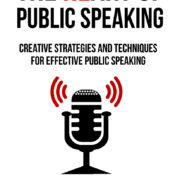FORCE people to remember your Presentations
We all know visuals matter, stories count and drama has a large impact on how we remember, recall and react to new information. The truth is that how we first store or remember influences or ability to recall and act upon new data. In fact, this truth has a certain science and structure to memorizing and making things memorable for your audience during presentations. The following is an excerpt from my book, The HeART of Public Speaking. The model is simple enough to put into practice for any kind of presentations.

Mind Map your way through the Head, Heart and Humor behind Public Speaking.
“The way we store information in our minds is similar to how we store books on a shelf.
Besides storing them alphabetically or by subject and author, we also tend to look, feel and size up the book before thinking about where it should go. The first book, let’s say, we place becomes our primary reference point and we then also arrange other books by how long we’ve had them, how often we refer to them and how relevant they are to our studies. Starting with that reference point, each group develops a certain “neighborhood” of its own.
Likewise, new information and new learning also chunks itself up — like an internal “bookshelf” — in our memory by time, usage, relevance and novelty.
Taking into account this fact about how our memory works and using an acronym–FORCE, we can create a template for highly memorable presentations.
F is for First: Experiences like your first date and your first plane ride are hard to forget. Similarly, the opening lines of a speech also have a lasting impression on our minds. This is also referred to as the “Law of Primacy.”
O is for Often: People you see regularly on the bus, a billboard en route to work or a song that you hear again glues easily on our memory. Similarly, in speaking, some repetition and rephrasing, creates better recall. This is also referred to as the “Law of Repetition.”
R is for things you can easily Relate to: Things such as a face in a crowd similar to your own ethnicity or someone wearing a shirt in your favorite color. In speaking, ideas and opinions the audience can quickly relate to, improve absorption and recall. This is also called the “Law of Relevance.”
C is for Catchy: Details or objects that are strikingly different from their environment, like a big white man in a crowd of Asians or a red hat amongt a lot of white ones. In public speaking, it is a good idea to include a colorful or a catchy phrase in our talks. This is also referred to as the “Law of Outstanding-ness.”
E is for Endings: People tell dozens of stories about having seen someone for the very last time or of their last visit abroad. Just like things that are heard, seen, or felt at the end stay longer on the “desktop” of your memory. In public speaking making your closings powerful makes the whole presentation impressive. This is also referred to as the “Law of Recency.”
Therefore, while researching data to include in our presentations, it’s a good idea to look out for things that…
• will create a good First impression;
• can be mentioned Often but in different words;
• the audience can Relate to easily;
• are different and Catchy;
• will create a lasting impression in the End.
And, while constructing speeches, keeping in mind the principles of FORCE will make our speeches/presentations memorable and impact-laden.”
When I, sometimes, look back at this model I feel that such a flow of thought…FORCE can also be a way to structure your presentations and talks. Yes!




Leave a Reply
Want to join the discussion?Feel free to contribute!